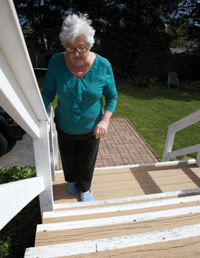A number of recent studies have highlighted the increased risk of falls and car accidents among glaucoma patients. Now, new research published online in the journal Eye and Brain may help to explain why.

Glaucoma slows saccadic eye movements, necessary for activities of daily living. Photo: Mark Lorenz
Neeru Gupta, MD, PhD, MBA, and a team of researchers at St. Michael’s Hospital in Toronto found that saccadic eye movements are significantly delayed in patients with glaucoma, even in those in the early stages of disease. These movements are key in our everyday lives, especially for scanning and navigating the surrounding environment.
“Now that we know that eye movement reaction times are delayed in people with glaucoma, there is an opportunity to understand the effects of glaucoma on daily activities of living that most of us take for granted, such as walking up and down stairs, driving, navigating and reading,” says Dr. Gupta, chief of glaucoma at the University of Toronto. “Just as alcohol causes a delay in hitting the brakes, glaucoma slows the time it takes to move the eyes quickly in response to a visual cue.”
His team found that eye movement reaction times in glaucoma patients were delayed by about 15% compared to subjects without glaucoma. Also of interest, saccade parameters showed no significant correlation with visual field loss in glaucoma patients.
Dr. Gupta foresees that measuring these reaction times could provide a useful way to quantify visual loss in glaucoma patients, beyond eye charts or visual field tests.
Kanjee R, Yücel YH, Steinbach MJ, et al. Delayed saccadic eye movements in glaucoma. Eye and Brain. 2012 Nov;(4):63-8.

